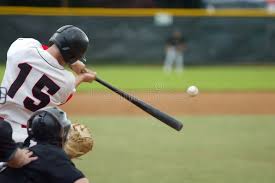
I recently stumbled onto a FanGraphs article written by Eno Sarris (2015) that discussed the problem with promoting the “chopping wood” approach to swing plane. Within the discussion was an interesting finding from Dr. Alan Nathan, a professor at the University of Illinois. According to Dr. Nathan, the long held belief in baseball circles that backspin adds distance to ball flight is not the truism it is believed to be. In his published experiment (
baseball.physics.illinois.edu), Dr. Nathan concluded that the increase in lift a hitter gains from hitting a ball with backspin is counterbalanced by the increase in drag the backspin creates (2014). Thus, the impact backspin has on the distance a ball travels is negligible at best.
When considering the applications of this information, those who advocate the “chopping wood” approach are faced with data that contradicts their coaching (Parker, 2015; Pippitt, 2011). If the purpose of the ax chop is to create backspin on the baseball and generate more power, then the notion that backspin is relatively meaningless when it comes to the distance a ball travels (especially when compared to things like exit velocity and launch angle) should be yet another data point that causes these coaches to investigate their personal dogma. Between the access to high-speed video, the omnipresent nature of scientific information on the swing, and the words of many major league players and coaches alike, it has become more and more difficult to justify teaching the “chopping wood” approach to hitting.
More broadly, the influx of information into the game of baseball should promote more scientific investigation done by coaches. While coaches may not have access to a physics laboratory, coaches do not lack for participants for any study they wish to conduct. High school coaches may have anywhere from 30 to 60 players in their program. Many college coaches have above 30 as well. Youth programs, private hitting instructors, and travel baseball coaches all have access to willing participants. If nothing else, a coach should take some time to reevaluate coaching points they regularly use. Whether they are long held beliefs, or new found data sets, presenting coaching points without conducting personal research or doing testing is not responsible coaching, it’s faith.
In addition to regular analysis of their standard coaching points, coaches should continue to seek opportunities for professional development. Sadly, coaching is one of the few professions that does not require professional development for a large portion of its practitioners. People who consider themselves to be serious practitioners in the coaching profession do their players and programs a significant disservice when they fail to seek professional development opportunities. There is no shortage of opportunities available. There are numerous yearly conventions (like the ABCA) at the national and state level where coaches can hear speakers present, interact with other coaches, and look at different products that can aid in training their players.
Outside of coaching clinics and conventions, coaches should consider visiting other successful coaches outside of their usual circle. There are so many stories about football and basketball coaches touring the nation to visit top programs and interact with their coaching staff. Baseball should be no different. Many places also host free webinars for coaches who lack the necessary resources to travel. Finally, social media can provide an excellent source of information as well. Videos, gifs, articles, and elite coaches can all be found on social media. If a coach is serious about continuing his education, opportunities for improvement abound. Coaches serve at the pleasure of their players, so they have an obligation to seek knowledge and to test new information.
References
Nathan, A. M., Kensrud, J., Smith, L., & Lang, E. (2014, December 9). Baseball Prospectus | Prospectus Feature: How Far Did That Fly Ball Travel (Redux)? Retrieved from
http://www.baseballprospectus.com/article.php?articleid=25167#ifrndnloc
Parker, R. (2015, May 23). Baseball Prospectus | Going Yard: The Near Perfection of Pederson. Retrieved from
http://www.baseballprospectus.com/article.php?articleid=26424
Pippitt, C. (2011, May 27). WARNING!! Down and Through EQUALS Down in the Lineup. Retrieved from
http://baseballrebellion.com/cpippitt/the-myths-of-hitting-down-and-through/
Sarris, E. (2015, September 9). Hitters: Quit Chopping Wood, Don’t Go for Backspin | FanGraphs Baseball. Retrieved from
http://www.fangraphs.com/blogs/hitters-quit-chopping-wood-dont-go-for-backspin/